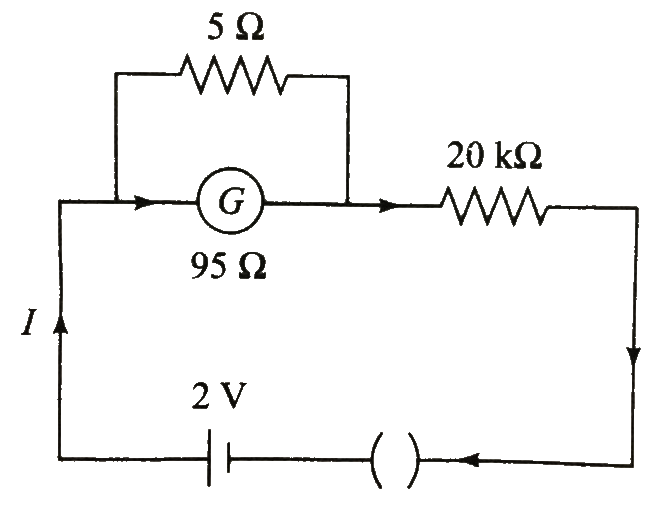The deflection in a moving coil galvanometer falls from 50 divisions when a shunt of 2Ω is applied. What is the resistance ( in ohms ) of the galvanometer ?
The correct Answer is:8
To solve the problem, we need to determine the resistance of the galvanometer (G) when a shunt resistance (S) of 2 ohms is applied, and the deflection changes from 50 divisions to 10 divisions.
1. Identify the Initial and Final Conditions:
- Initial deflection = 50 divisions
- Final deflection with shunt = 10 divisions
- This means the current through the galvanometer (Ig) when the deflection is at 10 divisions is less than the current when it was at 50 divisions.
2. Define the Current Values:
- Let the full-scale deflection current be represented as I.
- Therefore, the current through the galvanometer when it was at 50 divisions is 50I.
- The current through the galvanometer when it is at 10 divisions is 10I, which we denote as Ig.
3. Using the Current Division Rule:
- The total current (I) splits between the galvanometer and the shunt.
- The current through the shunt (Is) can be expressed as:
Is=I−Ig=I−10I=40I
4. Applying the Relationship for Parallel Resistors:
- The voltage across the galvanometer (Vg) and the shunt (Vs) must be equal since they are in parallel:
Vg=Ig⋅G=Is⋅S
- Substituting the expressions for Ig and Is:
10I⋅G=40I⋅2
5. Simplifying the Equation:
- Cancel I from both sides (assuming I ≠ 0):
10G=80
- Solving for G gives:
G=8010=8ohms
6. Conclusion:
- The resistance of the galvanometer is 8 ohms.
- Initial deflection = 50 divisions
- Final deflection with shunt = 10 divisions
- This means the current through the galvanometer (Ig) when the deflection is at 10 divisions is less than the current when it was at 50 divisions.
- Let the full-scale deflection current be represented as I.
- Therefore, the current through the galvanometer when it was at 50 divisions is 50I.
- The current through the galvanometer when it is at 10 divisions is 10I, which we denote as Ig.
- The total current (I) splits between the galvanometer and the shunt.
- The current through the shunt (Is) can be expressed as:
Is=I−Ig=I−10I=40I
- The voltage across the galvanometer (Vg) and the shunt (Vs) must be equal since they are in parallel:
Vg=Ig⋅G=Is⋅S
- Substituting the expressions for Ig and Is:
10I⋅G=40I⋅2
- Cancel I from both sides (assuming I ≠ 0):
10G=80
- Solving for G gives:
G=8010=8ohms
- The resistance of the galvanometer is 8 ohms.
Topper's Solved these Questions
- CURRENT ELECTRICITYBOOK - AAKASH INSTITUTE ENGLISHCHAPTER - CURRENT ELECTRICITYEXERCISE - ASSIGNMENT SECTION-H ( MULTIPLE TRUE-FALE TYPE QUESTIONS)
5 Videos
- CURRENT ELECTRICITYBOOK - AAKASH INSTITUTE ENGLISHCHAPTER - CURRENT ELECTRICITYEXERCISE - ASSIGNMENT SECTION-I(SUBJECTIVE TYPE QUESTIONS)
14 Videos
- CURRENT ELECTRICITYBOOK - AAKASH INSTITUTE ENGLISHCHAPTER - CURRENT ELECTRICITYEXERCISE - ASSIGNMENT SECTION-J(MATRIX-MATCH TYPE QUESTIONS)
2 Videos
- COMMUNICATION SYSTEMS BOOK - AAKASH INSTITUTE ENGLISHCHAPTER - COMMUNICATION SYSTEMS EXERCISE - ASSIGNMENT SECTION D (Assertion-Reason)
10 Videos
- DUAL NATURE OF RADIATION AND MATTER BOOK - AAKASH INSTITUTE ENGLISHCHAPTER - DUAL NATURE OF RADIATION AND MATTER EXERCISE - ASSIGNMENT (SECTION-D)
10 Videos
Similar Questions
The deflection in a moving coil galvanometer is
View SolutionThe deflection in a moving coil galvanometer falls from 50 divisions to 10 divisions when a shunt of 12 ohm is applied. What is the resistance of the galvanometer?
View Solutionthe deflection in a moving coil galvenometre falls from 50 divisions to 10 divisions when a shunt of 12Ω is applied. What is the resistance of the galvenometre? Assume the main current to remain same.
View SolutionThe deflection in a galnometer falls from 50 divisions to 20 divisions, when a 12Ω shunt is applied. The galvanometer resistance is
View SolutionThe deflection in moving coil galvanometer is reduced to half when it is shunted with a 40Ω coil . The resistance of the galvanometer is
View SolutionWhen a 12Ω resistor is connected with a moving coil galvanometer, then its deflection reduces form 50 divisions to 10 divisions. The ressitance of the galvanometer is
View SolutionIf in a moving coil galvanometer, a current I produces a deflection θ, then
View SolutionA galvanometer has resistance 36Ω if a shunt of 4Ω is added with this, then fraction of current that passes through galvanometer is:
View SolutionA galvanometer of resistance 20Ω is shunted by a 2Ω resistor. What part of the main current flows through the galvanometer ?
View SolutionA galvanometer of resistance 95Ω, shunted resistance of 5Ω, gives a deflection of 50 divisions when joined in series with a resistance of 20kΩ and a 2V accumulator. What is the current sensitivity of the galvanomter (in div/μA)?

View Solution
